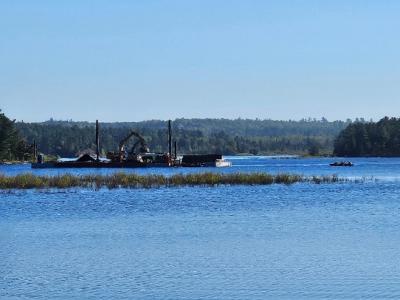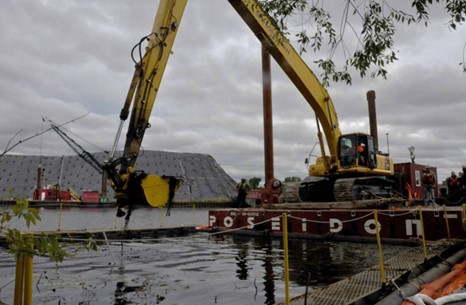Thomson Reservoir Remedial Action Project Wraps Up First Season of Construction
josterme01
Mon, 12/16/2024 – 3:20 pm
Crews place pelletized activated carbon at the Thomson Reservoir during the 2024 construction season. (Credit: Minnesota Pollution Control Agency)
The EPA has completed the first year of construction for the Thomson Reservoir Remedial Action project. This two-year, $35 million project is being conducted under Great Lakes Legacy Act and is funded in partnership with the Minnesota Pollution Control Agency and a private non-federal partner. The project is the final sediment remediation site on the Minnesota side of the St. Louis River Area of Concern. Completion of this project will progress efforts to remove the Restrictions on Dredging Activities and Degradation of Benthos Beneficial Use Impairments in the AOC, with the eventual goal of delisting the AOC.
Thomson Reservoir is a 330-acre reservoir with legacy contamination from dioxins/furans in the reservoir’s sediments as a result of decades of industrial pollution. Within the reservoir, sediment contamination was identified in 69 acres totaling 225,000 cubic yards. To address this contamination, 1-2.5 inches of activated carbon will be place in the contaminated areas. The activated carbon will bind to the contamination in the sediment and reduce their bioavailability, preventing contaminants from moving up the food chain.
During the 2024 construction season, crews placed 8,310 tons of activated carbon material over 28 acres of the reservoir. Placement of activated carbon will resume in 2025 to address the remaining 41 acres of contaminated sediment.
As the reservoir is a popular destination for the public, especially the recreational paddlers who actively use the reservoir and its outfalls, public access to the reservoir has been maintained throughout construction. Coordination is ongoing with local stakeholders to ensure a safe environment for paddlers who share the water with heavy machinery. Additionally, the reservoir’s parking area was expanded at the start of construction to accommodate needs for both public parking and a construction staging area.
Mon, 12/16/2024 – 3:20 pm
Keywords
St. Louis River AOC
sediment
Crews place pelletized activated carbon at the Thomson Reservoir during the 2024 construction season. (Credit: Minnesota Pollution Control Agency)
The EPA has completed the first year of construction for the Thomson Reservoir Remedial Action project. This two-year, $35 million project is being conducted under Great Lakes Legacy Act and is funded in partnership with the Minnesota Pollution Control Agency and a private non-federal partner. The project is the final sediment remediation site on the Minnesota side of the St. Louis River Area of Concern. Completion of this project will progress efforts to remove the Restrictions on Dredging Activities and Degradation of Benthos Beneficial Use Impairments in the AOC, with the eventual goal of delisting the AOC.
Thomson Reservoir is a 330-acre reservoir with legacy contamination from dioxins/furans in the reservoir’s sediments as a result of decades of industrial pollution. Within the reservoir, sediment contamination was identified in 69 acres totaling 225,000 cubic yards. To address this contamination, 1-2.5 inches of activated carbon will be place in the contaminated areas. The activated carbon will bind to the contamination in the sediment and reduce their bioavailability, preventing contaminants from moving up the food chain.
During the 2024 construction season, crews placed 8,310 tons of activated carbon material over 28 acres of the reservoir. Placement of activated carbon will resume in 2025 to address the remaining 41 acres of contaminated sediment.
As the reservoir is a popular destination for the public, especially the recreational paddlers who actively use the reservoir and its outfalls, public access to the reservoir has been maintained throughout construction. Coordination is ongoing with local stakeholders to ensure a safe environment for paddlers who share the water with heavy machinery. Additionally, the reservoir’s parking area was expanded at the start of construction to accommodate needs for both public parking and a construction staging area.
Mon, 12/16/2024 – 3:20 pm
Keywords
St. Louis River AOC
sediment











habitat
stormwater
infrastructure